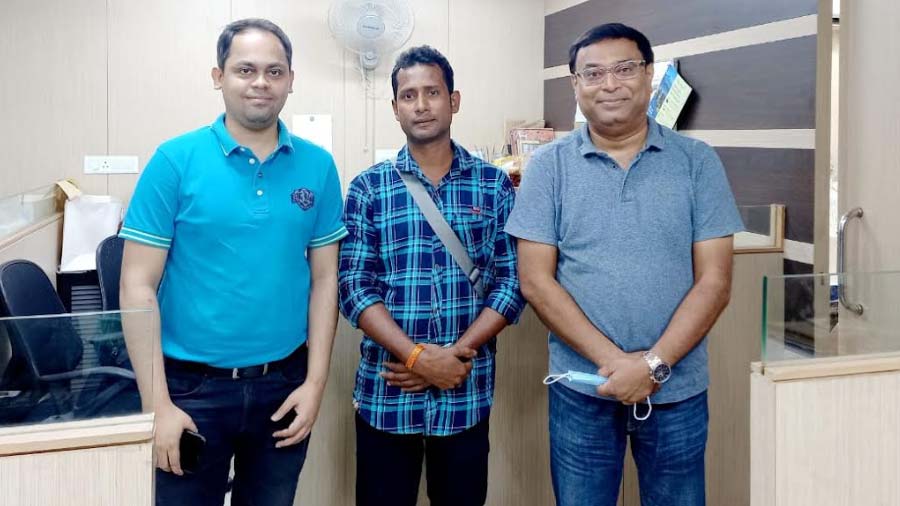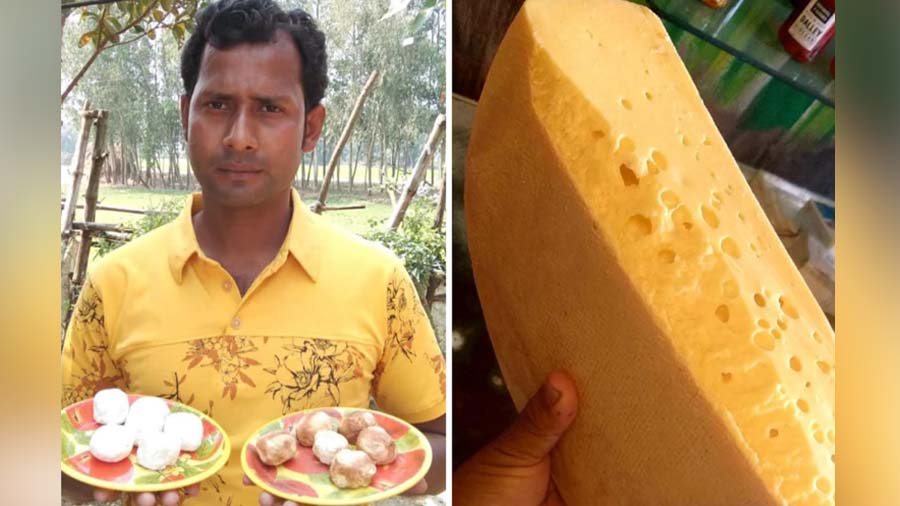“I still remember it quite well… on February 15 this year, The New York Times food writer Priya Krishna interviewed me for a story about Bandel cheese. A couple of days later, I received a phone call from (cheese maker) Palash (Ghosh), informing me that he is taking up a job as a caretaker at a resort in Jalpaiguri, and will have to quit making the cheese,” says Saurav Gupta, the founder of Kolkata’s The Whole Hog Deli.
One might say, what’s one less cheese maker? But Palash Ghosh was and is, seemingly, the only cheese maker left in the world who still makes Bandel cheese. The crumbly, dry cheese created by the Portuguese isn’t just sought-after, but currently ranks quite high on the global connoisseurial scale.
Kalimpong cheese, another settler’s cheese, was first made by the Swiss Jesuit Father Andre Butty (along with the now-iconic milk lollipop), at Kalimpong’s Swiss Welfare Dairy, sometime in the 1950s. Samuel Yonzon, a sound engineer-turned-cheese maker tells us that though he has been making cheese in Kalimpong for some time now, the original Swiss-style Kalimpong cheese hasn’t actually been produced since the dairy shut down in the ’70s.
“For roughly eight and a half years now, my partner and I have been trying to revive the lost tradition of making Kalimpong cheese. But what you see in the markets right now is not the old Kalimpong cheese that the Swiss dairy used to make,” Yonzon reveals.
While the Bandel cheese has got a new lease of life, thanks to the renewed attention it received from prominent names such as chefs Sanjeev Kapoor and Ranveer Brar, Kalimpong’s cheese may have a gritty road ahead.
My Kolkata spoke to Gupta and Yonzon to get a clearer picture of the future of these two native cheeses.
‘Bandel cheese has 400 years of documented history!’
The popular artisanal charcuterie brand, The Whole Hog Deli, owned by Gupta, has been exclusively selling Bandel cheese on their platform for a few months now. Gupta tells us that he has been trying to locate the makers of the Bandel cheese for years.
“I’ve known Palash’s family for a decade now. He’s a 11th generation cheese maker and it took me around one-and-a-half years to locate them. There was a lot being written about Bandel cheese, it had acquired global repute, and yet, very few people knew about the makers behind it. In New Market, it could be found in two stores, but no one really knew who was making them, despite Palash’s family selling the cheese to these retailers for decades!” Gupta shares.
“When I did find Palash and his family, they were quite apprehensive about talking about their work. But once the pandemic hit and physical stores shut, they were in monetary distress and could use a platform to sell the cheese. We started selling it in the city and also to some popular names across India, including The Bombay Canteen,” he adds.
In May this year, chef Ranveer Brar featured the cheese in one of his videos and shortly after shared an online petition with his followers to help it acquire a GI tag. “I had contacted celebrity chef Ranveer Brar to help us spread the word about Bandel cheese, and he immediately took up the cause,” Gupta says.
The classic Bandel cheese is made by pressing acid-coagulated, salted curds into morsels of fresh cheese, which are then generously smoked and dried. Soaking it overnight and rinsing it out before using can balance out its strong savouriness.
Thomas Bowrey notes in the Geographical Account of Countries Round the Bay of Bengal, 1669 to 1679, that the Portuguese settlers around the Bandel region started making cheese to replicate the light and creamy Queijo fresco cheese, roughly 400 years ago. But they eventually adopted the technique of smoking the cheese from their Dutch neighbours in Chinsurah, who shipped the smoked Bandel cheese to far-off countries including Batavia, which is present-day Jakarta.
But how did something so crucial to Bengal’s culinary history come so close to the brink of extinction? “You have to understand that the cheese wasn’t profitable to make anymore, it had a very niche appeal. After the Raj ended and after the Anglo-Indian population began migrating to other countries, its demand dwindled. It was not something that was used by the Bengali masses — it wasn’t usually used for Bengali recipes. So, the families who were making the cheese struggled to make a living,” Gupta reveals.
Interestingly, Bandel cheese isn’t made at Bandel anymore. Palash Ghosh’s father and uncle migrated to Bankura decades ago, and the family produces the cheese from their home, in the Kotulpur Block of Bankura.
“Even Palash had quit making the cheese, he had taken up a job as a caretaker at a resort in Lataguri. It was quite heartbreaking actually. Soon after that, I contacted Ranveer Brar and met Sanjeev Kapoor to help spread the word and we convinced Palash to keep making it,” Gupta reveals.

Salim Zafar of Biswa Bangla Marketing Corporation, cheese maker Palash Ghosh (centre) and Saurav Gupta of The Whole Hog Deli
Biswa Bangla, the state-run enterprise that promotes heritage products from Bengal, will soon start selling the cheese from their platform. Good tidings may be on the horizon vis-a-vis the GI tag as well.
“The Hooghly District administration is working towards it, they have formed a committee. I’m a part of it as well. The efforts are geared towards relocating Palash’s family to Bandel, where they can continue making it,” Gupta weighs in.
‘At the moment, Kalimpong cheese has a pseudo existence’
Samuel Yonzon left his job as a sound engineer to go back to Kalimpong and revive the Himlayan cheese-making culture in his home town. Yonzon, along with his associate Khushnarayan Sharma (who owns the Nature’s Heaven farm, Gitdabling), have been trying to bring back the original Kalimpong cheese that was introduced by Swiss missionaries in the 19th century.
Father Andre Butty, who founded the Swiss Welfare Dairy in the 1950s, was the first person to introduce the semi-hard, holey, gouda-style cheese to Kalimpong. The Swiss Dairy also made hand-rolled milk lollipops, which found cult popularity. The dairy fell to mismanagement and had to cease production around the ’70s.
“We make many kinds of cheese in Kalimpong, but it’s not the original Swiss-style cheese that had first found popularity. For the past eight-and-a-half years, my associate and I have been trying to revive the lost technique. The target temperature for maturing this particular cheese is between 12-13 degrees Celsius. The constant we’ve achieved so far is around 17 degrees. We have created a subterranean cellar, but we still haven’t been able to achieve the temperature. At this point, we need more funds to be able to make the cheese,” Yonzon shares.
More recently, Yonzon bought in a cheese expert from Chennai and expanded his business by leasing a new farm to focus his efforts at producing the lost cheese. However, the pandemic-induced setback has made it harder for local businesses to secure loans.
“There have been other people who have been making cheese in the area, but again, none of the variants shared the profile or the depth of the cheese made by the Swiss Dairy, because there are microbial factors that come into play. Plus, the temperature in Kalimpong is 35 degrees in summer, it’s much hotter than it used to be. We’ve been very transparent about what we’re selling and what we haven’t been able to make. It’s a pseudo-existence; it’s not the real thing,” Yonzon points out.
Although Yonzon has sold similar cheese under his label, it was sourced from Pashupati Nagar in Nepal, which is at a higher altitude and is hence more suited to producing this variant.
“The market here is limited. If I make paneer, my friend can also make it. There would be competition and demand would go down. But cheese is a wonderful thing, it can change every 20 kms. Eight years ago, there were no local companies that pasteurised milk. Now there are seven micro companies like ours who are doing it,” Yonzon says.
The cheese maker’s vision, though, has always been community-oriented.
“The reason we want to revive the original Kalimpong cheese is so that our friends and nearby brands can also make it and explore the possibilities. Eventually, they may create something that will enrich Kalimpong further. That has always been our goal,” he adds.
Yonzon, who has sold yak cheese in the past (which he tells us, is not too different from Parmigiano Reggiano in texture), points out that the harder the cheese and the lower the moisture content, the easier it is to handle and will also last longer.
“The one we’re trying to make may actually last for two to three years if stored properly. It’s holey and in a way, it’s similar to Emmental, not as big though. A GI tag and the recognition can be a wonderful thing for us. But the only thing standing in our way is funds, which is quite unfortunate,” says Yonzon.
Explore Yonzon’s brand Healthilicious Kalimpong here.
